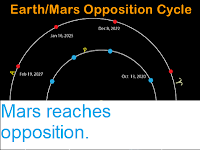The planet Neptune will reach opposition (i.e. be directly opposite the
Sun seen from Earth) on Friday 7 September 2018. This
means that it will both be at its closest to the Earth this year, about
28.93 AU (28.96 times the average distance between the Earth and the
Sun, or about 4 328 336 000 km), and completely illuminated by the Sun.
While it is not visible to the naked eye observer, the planets have
phases just like those of the Moon; being further from the Sun than the
Earth, Neptune is 'full' when directly opposite the Sun. As this falls only two days before the New Moon, the prospects for viewing for those equipped with suitable telescopes is quite good.
The relative positions of Earth and Neptune at opposition. Derekscope.
Neptune orbits the Sun at an average distance of 30.11 AU, completing one
orbit around the Sun every 165 years. This means that the planet is
almost stationary compared to the faster moving Earth, so that it
reaches Opposition only four days later each year than the year
before, and reaches Solar Conjunction (when it is directly on the opposite side of the Sun to the Earth), roughly six months later.
See also...
Follow Sciency Thoughts on Facebook.







